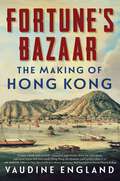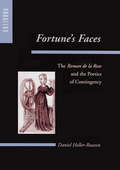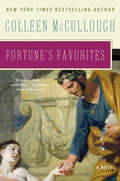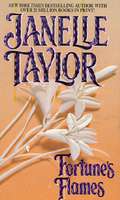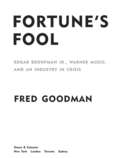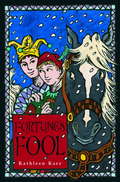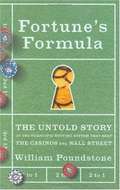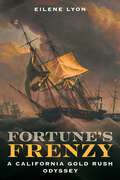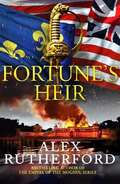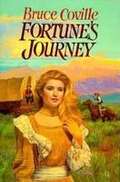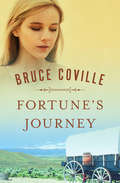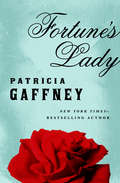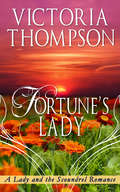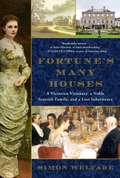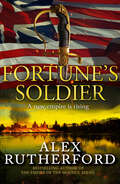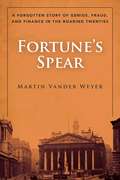- Table View
- List View
Fortune's Bazaar: The Making of Hong Kong
by Vaudine EnglandA timely, well-researched, and &“illuminating&” (The New York Times Book Review) new history of Hong Kong that reveals the untold stories of the diverse peoples who have made it a multicultural world metropolis—and whose freedoms are endangered today.Hong Kong has always been many cities to many people: a seaport, a gateway to an empire, a place where fortunes can be dramatically made or lost, a place to disappear and reinvent oneself, and a melting pot of diverse populations from around the globe. A British Crown Colony for 155 years, Hong Kong is now ruled by the Chinese Communist Party. Here, renowned journalist Vaudine England delves into Hong Kong&’s complex history and its people—diverse, multi-cultural, cosmopolitan—who have made this one-time fishing village into the world port city it is today. Rather than a traditional history describing a town led by British Governors or a mere offshoot of a collapsing Chinese empire, Fortune&’s Bazaar is &“a winning portrait of Hong Kong&’s vibrant mosaic&” (Publishers Weekly). While British traders and Asian merchants had long been busy in the Indian and South East Asian seas, many people from different cultures and ethnic backgrounds arrived in Hong Kong, met, and married—despite all taboos—and created a distinct community. Many of Hong Kong&’s most influential figures during its first century as a city were neither British nor Chinese—they were Malay or Indian, Jewish or Armenian, Parsi or Portuguese, Eurasian or Chindian—or simply, Hong Kongers. England describes those overlooked in history, including the opium traders who built synagogues and churches; ship owners carrying gold-rush migrants; the half-Dutch, half-Chinese gentleman with two wives who was knighted by Queen Victoria; and the gardeners who settled Kowloon, the mainland peninsula facing the island of Hong Kong, and became millionaires. A story of empire, race, and sex, Fortune&’s Bazaar presents a &“fresh…essential&” (Ian Buruma), &“formidable and important&” (The Correspondent) history of a special place—a unique city made by diverse people of the world, whose part in its creation has never been properly told until now.
Fortune's Bride
by Judith E. FrenchIn a time of revolution, a fiery young widow may have to compromise more than her politics...As British soldiers swarm her Maryland plantation, Caroline Steele must feign loyalty to the Crown to protect her home. But she is in danger of losing everything when a fugitive chooses her bedroom as his hiding place--and effectively ruins her reputation. Now the scoundrel owes Caroline his life--a debt she demands he pay--with marriage...Rebel sea captain Garrett Faulkner never planned to take a wife. But Caroline has him undeniably trapped--and tempted. With the British on his heels, and a murderous suitor after her fortune, both have much to lose--and more to gain than their hearts dare imagine. For marriage is merely one part of a bargain filled with secrets, adventure--and irresistible desire...150,000 Words
Fortune's Bride: Book 3 (Brides of Montclair #3)
by Jane PeartSlowly she turned to face the door just as Graham came through at full stride. At the sight of him a wild kind of joy seized her. Graham halted on the threshold. He drew in his breath sharply, and in spite of himself, his pulse thundered at the sight of the tall, willowy figure. The last time he had seen Avril she had been a child. Here in her place was a graceful young woman. "Avril, my dear," he said, finding his voice. "Welcome home!" Fortune's Bride, the third in a series of award-winning novels by Jane Peart, is a revision of the story of Avril Dumont, a wealthy young heiress and orphan, who gradually comes to terms with her lonely adolescence. There is romance and heartbreak, true love and fulfillment in this story of Avril's seemingly unreturned but undaunted love for her bachelor guardian, Graham Montrose. Readers of Fortune's Bride will be smitten with the charm of the old South as they follow Avril's development into womanhood, and meet the people who give her a sense of self-worth. So skillfully drawn is the plot of this romance that the reader will suffer form ongoing suspense throughout Avril's story.
Fortune's Captive
by Elizabeth TurnerWHISPERS OF SCANDAL, WHISPERS OF PASSION Lovely Juliana Butterfield 'was an innocent, only a week removed from the shelter of a convent... and filled with secret longings for a man's tender caress. Andrew MacAllister was worldly and sophisticated, driven by his powerful ambitions-and powerful desires. They never would have dreamed that in the midst of scandal, their worlds would collide. But forced into each other's arms, they would discover an all-consuming hunger... a passion both unexpected-and unforgettable!
Fortune's Faces: The Roman de la Rose and the Poetics of Contingency (Parallax: Re-visions of Culture and Society)
by Daniel Heller-RoazenArguably the single most influential literary work of the European Middle Ages, the Roman de la Rose of Guillaume de Lorris and Jean de Meun has traditionally posed a number of difficulties to modern critics, who have viewed its many interruptions and philosophical discussions as signs of a lack of formal organization and a characteristically medieval predilection for encyclopedic summation. In Fortune's Faces, Daniel Heller-Roazen calls into question these assessments, offering a new and compelling interpretation of the romance as a carefully constructed and far-reaching exploration of the place of fortune, chance, and contingency in literary writing.Situating the Romance of the Rose at the intersection of medieval literature and philosophy, Heller-Roazen shows how the thirteenth-century work invokes and radicalizes two classical and medieval traditions of reflection on language and contingency: that of the Provençal, French, and Italian love poets, who sought to compose their "verses of pure nothing"in a language Dante defined as "without grammar," and that of Aristotle's discussion of "future contingents" as it was received and refined in the logic, physics, theology, and epistemology of Boethius, Abelard, Albert the Great, and Thomas Aquinas.Through a close analysis of the poetic text and a detailed reconstruction of the logical and metaphysical concept of contingency, Fortune's Faces charts the transformations that literary structures (such as subjectivity, autobiography, prosopopoeia, allegory, and self-reference) undergo in a work that defines itself as radically contingent. Considered in its full poetic and philosophical dimensions, the Romance of the Rose thus acquires an altogether new significance in the history of literature: it appears as a work that incessantly explores its own capacity to be other than it is.
Fortune's Favorites (Masters Of Rome Ser. #No. 3)
by Colleen McCulloughWith incomparable storytelling skill, New York Times bestselling author Colleen McCullough brings Rome alive in all her majesty—and illuminates the world of those favored by the gods at birth.In a time of cataclysmic upheaval, a bold new generation of Romans vied for greatness amid the disintegrating remnants of their beloved Republic. They were the chosen...and the cursed—blessed with wealth and privilege yet burdened by the dictates of destiny in a savage struggle for power that would leave countless numbers crushed and destroyed. But there was one who would tower above them all—a brilliant and beautiful boy whose ambition was unparalleled, whose love was legend, and whose glory was Rome's: a boy they would one day call "Caesar."
Fortune's Flame
by Judith E. FrenchAn outlaw Scotsman and a manor's independent young mistress form an unconventional partnership--in adventure and in love. . .Pirate, convict, and runaway bond servant, Kincaid is just the man Lady Elizabeth Lacy Bennett has been searching for. Now he's found, and as far as Bess is concerned, hanging is too easy an escape for the scoundrel who stole her beloved horse--and dared to repay her with a searing kiss. For despite his crimes, Kincaid is a valuable worker--worth every penny she has paid for his indenture--and the ideal guide to help find a lost treasure that could save her Maryland plantation from ruin. She may be mad to trust the charismatic Scotsman, for it's clear he desires more from her than freedom, but Bess was raised to finish what she starts, and to follow her heart--even if she may lose it. . ."A superb storyteller. . .I loved it!" --Linda Ladd150,000 Words
Fortune's Flames
by Janelle TaylorMaren James was unprepared for the torrent of emotions that engulfed her when her ship was boarded by the notorious Captain Hawk. Impatience turned to raging desire when the dashing buccaneer strode into her cabin, and before she could think to resist, the luscious ebon-haired beauty was succumbing to the pirate's masterful touch.
Fortune's Fool
by Fred GoodmanIn 1999, when Napster made music available free online, the music industry found itself in a fight for its life. A decade later, the most important and misunderstood story--and the one with the greatest implications for both music lovers and media companies--is how the music industry has failed to remake itself. In Fortune's Fool, Fred Goodman, the author of The Mansion on the Hill, shows how this happened by presenting the singular history of Edgar M. Bronfman Jr., the controversial heir to Seagram's, who, after dismantling his family's empire and fortune, made a high-stakes gamble to remake both the music industry and his own reputation. Napster had successfully blown the industry off its commercial foundations because all that the old school label heads knew how to do was record and market hits. So when Bronfman took over the Warner Music Group in 2004, his challenge was to create a new kind of record executive. Goodman finds the source of the crisis in the dissolution of the old Warner Music Group, the brilliant conglomerate of Atlantic, Elektra, and Warner Bros. Records. He shows how Doug Morris, the head of Atlantic Records, rose through the ranks and rode the CD bonanza of the 1990s to enormous corporate and personal profit before becoming embroiled in an ego-driven corporate turf war, and how all of Warner's record executives were blindsided when AOL/Time-Warner announced in 2003 that it wanted nothing more to do with the record industry. When the music group was finally sold to Bronfman, it was a ghost of itself. Bronfman built an aggressive, streamlined team headed by Lyor Cohen, whose relentless ambition and discipline had helped build Def Jam Records. They instituted a series of daring initiatives intended to give customers legitimate online music choices and took market share from Warner's competitors. But despite these efforts, illegal downloads still outnumber legitimate ones 19-1. Most of the talk of a new world of music and media has proven empty; despite the success of iTunes, even wildly popular sites like YouTube and MySpace have not found a way to make money with music. Instead, Warner and the other labels are diversifying and forcing young artists to give them a cut of their income from touring, publishing, and merchandising. Meanwhile, the average downloader isn't even meeting forward-thinking musicians halfway. Each time a young band finds a following through music websites, it's a unique story; no formula has emerged. If one does, Warner is probably in a better position than anyone to exploit it. But at the end of the day, If is the one-word verdict on Bronfman's big bet.
Fortune's Fool
by Kathleen Karr“A well-mapped medieval road trip. ”—The Bulletin Orphaned and left to make his own way in the world, Conrad the Good serves as court jester to a most unworthy master: Lord Otto “the Witless,” who rarely appreciates jesting and acrobatics and more often rewards his good fool with a good whipping. So one night, Conrad flees, leaving Otto’s realm in search of a more enlightened master—taking with him only his noble horse, Blackspur, and his beloved, the servant girl Christa the Fair. As they take to the road, they soon learn that along with their quest comes hardship. But with Christa disguised as a boy, they are able to make their way as traveling entertainers, and for all the difficulties they encounter, there are as many unexpected joys and friends in unexpected places, and there is their love for one another. And always, their destination lies before them: somewhere, a sanctuary where they’ll have the freedom to be together and be themselves.
Fortune's Fools
by Julia ParksHis Promise Ready or not, the Honorable Maxwell Darby and his younger brother Tristram must brave the glittering world of London Society to hunt for heiresses, lovely or not. Scurrilous rumors abound: can it be true that their father, Lord Tavistoke, lost the family fortune in a card game? And is the Marquis of Cravenwell, a notorious gambler, behind the artful scheme to marry off Tavistoke's sons to the highest bidders? But Maxwell will have none of it, for his heart has been stolen by a certain young lady who is as spirited-and as penniless-as he: Kate O'Connor, the beautiful, red-haired daughter of an Irish horse trainer. Her Vow But Kate won't even kiss him-she knows only too well that Maxwell Darby must and will marry for money. His ardent attentions are nothing more than a passing fancy, but she sees no reason to deny herself the innocent pleasure of his company. Her reputation? Well, that is no one's concern but her own...until the handsome young nobleman makes a startling confession. And Kate discovers that her most cherished dreams may be about to come true...
Fortune's Formula: The Untold Story of the Scientific Betting System That Beat The Casinos And Wall Street
by William PoundstoneIn 1956 two Bell Labs scientists discovered the scientific formula for getting rich. One was mathematician Claude Shannon, neurotic father of our digital age, whose genius is ranked with Einstein's. The other was John L. Kelly Jr. , a Texas-born, gun-toting physicist. Together they applied the science of information theory-the basis of computers and the Internet-to the problem of making as much money as possible, as fast as possible. Shannon and MIT mathematician Edward O. Thorp took the "Kelly formula" to Las Vegas. It worked. They realized that there was even more money to be made in the stock market. Thorp used the Kelly system with his phenomenally successful hedge fund, Princeton-Newport Partners. Shannon became a successful investor, too, topping even Warren Buffett's rate of return. Fortune's Formula traces how the Kelly formula sparked controversy even as it made fortunes at racetracks, casinos, and trading desks. It reveals the dark side of this alluring scheme, which is founded on exploiting an insider's edge. Shannon believed it was possible for a smart investor to beat the market-and Fortune's Formula will convince you that he was right. William Poundstone is the bestselling author of nine nonfiction books, including Labyrinths of Reason and The Recursive Universe. "Fortune's Formula may be the world's first history book, gambling primer, mathematics text, economics manual, personal finance guide and joke book in a single volume. Poundstone comes across as the best college professor you ever had, someone who can turn almost any technical topic into an entertaining and zesty lecture. "-The New York Times Book Review
Fortune's Frenzy: A California Gold Rush Odyssey
by Eilene LyonThe road to hell is paved with good intentions…and gold dust. When Henry Jenkins&’s sawmill business goes bust and his family loses their Indiana farm to foreclosure, he sees gold as the answer to his financial woes. Joining a company of younger men, Jenkins and the other prospective miners sign fraudulent promissory notes to borrow from a ruthless businessman, Allen Makepeace, to reach the gold mines. They sail the risky route via Panama to the mines in 1851. But gold is not so easy to find by then. Making enough to survive and get home will be difficult; repaying Makepeace could be impossible. As Henry Jenkins becomes mired in mining, his wife, Abby, struggles to meet the needs of her large family amidst crop failures, waves of deadly disease, and harassment by Henry&’s creditors. When Henry&’s sons-in-law follow in his wake, they find themselves on a notorious death ship, stranded in the vast Pacific. Will any of these frantic men make it home to their distressed families? Fortune&’s Frenzy reveals the plight of miners who borrowed at extortionate rates to get to California, and explores the dangerous and deadly sea routes to the west coast that killed roughly 10 percent of those who risked the journey. Alternating between the miners&’ trials and terrors, and the challenges for the wives, children, and mothers left behind, Fortune&’s Frenzy delves into the country&’s pressing social, economic, and nationalist issues in the pre-Civil War decades. The theme is age-old, and still relevant: desperate people falling for get-rich-quick schemes. They fail to consider the sacrifices they will have to make and the dismal odds of their success.
Fortune's Heir: The Ballantyne Chronicles Book #2
by Alex RutherfordThe long-anticipated sequel to Fortune's Soldier, from the author of the Empire of the Moghul series. In his Himalayan retreat of Glenmire, Nicholas Ballantyne is determined his days of bloodshed and intrigue in the service of the British East India Company are over. Yet the Battle of Plassey, where he fought with Robert Clive, has delivered only a short-lived peace and the 1770s are precarious times in India. Martial Marathas, formidable Sikhs and wild Afghan Rohillas threaten not only each other, but the Company’s very existence. Most dangerous of all are the militarily astute Hyder Ali and his charismatic son Tipu Sultan, the Tiger of Mysore, who – with strong French support – are intent on driving the British into the sea. When Warren Hastings, the Company’s newly appointed Governor-General, beset by internal rivalries, seeks Nicholas’ help, he agrees. Though long-cynical about the Company, he foresees a bloodbath that could rip India apart, cause thousands of deaths and imperil his own family. A quiet life must wait.
Fortune's Journey
by Bruce CovilleSixteen-year-old Fortune Plunkett faces many challenges on an overland journey to California in 1853 with the acting company that she inherited from her father.
Fortune's Journey
by Bruce CovilleOn the Oregon trail, a theater troupe strives to reach California After months in the cramped confines of a Conestoga wagon, Fortune Plunkett is dreaming of the life she left behind in Charleston. It was her father's dream to lead his band of actors to California, but he died on the trail. Fortune's only inheritance is a trunk of old costumes, a handful of plays, and a passionate drive to reach the Pacific Ocean, no matter what hardships she might endure along the way. At the time of her father's death, the actors were heading toward an engagement in the little town of Busted Heights--a place that held a fascination for Fortune's father that he never explained. There Fortune meets the greenhorn Jamie Halleck, a naive young man who convinces her to let him join the group. With Jamie onboard, they hit the trail again, ready to reach California and find their destiny. This ebook features an illustrated personal history of Bruce Coville including rare images from the author's collection.
Fortune's Lady
by Patricia GaffneyOn the eve of the French Revolution, the daughter of a traitor might be the only one who can save the British Crown Cassandra Merlin is in dire straits. Her father, Patrick, has just been executed for treason against the British Crown. Her aunt, Lady Elizabeth Sinclair, is eager to marry her off rather than bear the expense of sheltering a turncoat&’s daughter. And when a handsome young patriot named Philip Riordan enters her life, Cass knows he is destined to complicate matters further. Riordan wants her to enter the spy game, to provide valuable information about her father&’s plot against the monarchy in order to save the king&’s life. But the intelligence game is never a simple one, and even a heart as jaded as Cass&’s may not be safe from the charms of Philip Riordan, renowned cad, Member of Parliament . . . and die-hard loyalist.
Fortune's Lady (A Lady and the Scoundrel #3)
by Victoria ThompsonA Lady and the Scoundrel Romance (#3)From Romantic Times Career Achievement Award Winner and New York Times bestseller Victoria Thompson, a sensual tale of historical romance in the American West..."Ms. Thompson imbues her characters with strength, eloquence and dignity." -Romantic TimesTHEY GAMBLED ALL THEY HAD ON THE PROMISE OF EVERLASTING LOVERaising her son on her own, fiery Suzanna Prentice isn't going to give up her hopes for a good life. So she takes a job as a dancehall girl in Dodge City's roughest saloon to pays the bills, though vulgar remarks from the drunken patrons wear on her spirit...until one passionate glance from a handsome gambler sets Suzanna's blood racing with hope...and burning desire. When fate and a gunman's bullet place the gorgeous gambler in Suzanna's tender loving care, a bond blossoms between the widow and her gambler, a tenderness neither one can deny. As Suzanna vows to heal the gambler's wounds, as well as his lonely heart, she falls head first into his secret world of danger...and the head-spinning, euphoric promise of everlasting love...
Fortune's Many Houses: A Victorian Visionary, a Noble Scottish Family, and a Lost Inheritance
by Simon WelfareA unique and fascinating look at Victorian society through the remarkable lives of an enlightened and philanthropic aristocratic couple, the Marquess and Marchioness of Aberdeen, who tried to change the world for the better but paid a heavy price. This is a true tale of love and loss, fortune and misfortune.In the late 19th century, John and Ishbel Gordon, the Marquess and Marchioness of Aberdeen, were the couple who seemed to have it all: a fortune that ran into the tens of millions, a magnificent stately home in Scotland surrounded by one of Europe&’s largest estates, a townhouse in London&’s most fashionable square, cattle ranches in Texas and British Columbia, and the governorships of Ireland and Canada where they lived like royalty. Together they won praise for their work as social reformers and pioneers of women&’s rights, and enjoyed friendships with many of the most prominent figures of the age, from Britain&’s Prime Ministers to Oliver Wendell-Holmes and P.T. Barnum and Queen Victoria herself. Yet by the time they died in the 1930s, this gilded couple&’s luck had long since run out: they had faced family tragedies, scandal through their unwitting involvement in one of the &“crimes of the century&” and, most catastrophically of all, they had lost both their fortune and their lands. This fascinating family quest for the reason for their dramatic downfall is also a moving and colorful exploration of society in Victorian Britain and North America and an inspirational feast for history lovers.
Fortune's Mistress
by Judith E. FrenchA smuggler's spirited daughter and the dashing illegitimate son of King Charles II find they have more in common than meets the eye. . .Chained together to prevent escape from the gallows, accused witch Lacy Bennett and pirate James Black appear destined for the noose. Only their quick wit and good looks save them from the violence of a hostile crowd. And thanks to a timely distraction, they are soon on a ship bound for the Caribbean--headed toward a hidden treasure. But false friends, treacherous greed, and danger at every turn only serve to bring them closer, and in each other they will find more to live for than gold. . .150,000 Words
Fortune's Rocks
by Anita ShreveNew England 1899:Vacationing with her parents, Olympia falls in love with a married friend of her father's. Pregnant, she is exiled. Years later she files suit to reclaim her lost child.
Fortune's Rocks
by Anita ShreveFortune's Rocks transports the reader to the turn of the twentieth century, to the world of a prominent Boston family summering on the New Hampshire coast...'No praise is too high for Fortune's Rocks. The book will take hold of you and not let you go until the last word' USA Today'Exceptionally fine . . . Shreve writes with power and passion' Daily ExpressFourteen-year-old Olympic Biddeford is spending the summer with her parents at their seasonal house at Fortune's Rocks. Her father handles her education himself and is in fact a publisher of mildly liberal literature. One author he admires, who also practises as a physician, comes to visit the house. Forty years old, married with four children, he embarks on an affair with Olympia. They have a swift, passionate summer, torn apart when they are discovered together during Olympic's fifteenth birthday party. Her parents are mortified and immediately take Olympia back to Boston. When a baby boy is born nine months later, he is taken from her and she finds herself in exile at a ladies college and then as a governess. She decides she must get her child back, which means returning to Fortune's Rocks...
Fortune's Soldier (Ballantyne Chronicles)
by Alex RutherfordPower, ambition, corruption – the British East India Company risesAn old empire at war with itself1744, Scotland. Young Nicholas Ballantyne’s life is turned upside down when his uncle, caught up in events far beyond his control, announces that, for his own safety, Nicholas is to set sail for India immediately to join the East India Company.A new power risingAfter decades of struggle, the Company is ready to expand. Nicholas and his new friend and colleague, the mercurial Robert Clive, rise quickly within the Company’s ranks, masterminding plans to counter French designs in India.A battle for survivalBut the fight for India will only be resolved in battle. On the fields of Plassey, the two armies draw up for the climactic encounter. For Robert and Nicholas, commanding the Company’s forces, this will be their making, or their end…Brilliantly crafted, and bringing to life the momentous events that shook India in the mid-eighteenth century, Fortune’s Soldier is an epic tale of a fascinating era by a master storyteller.
Fortune's Soldier (The Ballantyne Chronicles)
by James BarringtonPower, ambition, corruption – the British East India Company risesAn old empire at war with itself1744, Scotland. Young Nicholas Ballantyne’s life is turned upside down when his uncle, caught up in events far beyond his control, announces that, for his own safety, Nicholas is to set sail for India immediately to join the East India Company.A new power risingAfter decades of struggle, the Company is ready to expand. Nicholas and his new friend and colleague, the mercurial Robert Clive, rise quickly within the Company’s ranks, masterminding plans to counter French designs in India.A battle for survivalBut the fight for India will only be resolved in battle. On the fields of Plassey, the two armies draw up for the climactic encounter. For Robert and Nicholas, commanding the Company’s forces, this will be their making, or their end…Brilliantly crafted, and bringing to life the momentous events that shook India in the mid-eighteenth century, Fortune’s Soldier is an epic tale of a fascinating era by a master storyteller.
Fortune's Spear: A Forgotten Story of Genius, Fraud, and Finance in the Roaring Twenties
by Martin Vander WeyerGerard Lee Bevan was the epitome of an Edwardian swell-arrogant, smooth, and highly cultured. He married into money and influence and exploited a glittering range of social connections as the black sheep of one of London’s most respectable banking families. He could not uphold his many deceptions, however, despite a long run of success in city dealings, and perpetrated a massive fraud which ruined both the City Equitable Fire Insurance Company and his stockbroking firm, Ellis & Co. Bevan fled England in ruin in 1922, abandoning his family and business, and was eventually caught in Vienna, despite his desperate attempts at disguise. His sensational Old Bailey trial shocked the entire country.Fortune’s Spear is a parable of the way in which the prospect of easy money draws risk-takers in every era into a spiral of greed and deceit. Bevan may have been forgotten but he richly deserves to be remembered. In this richly detailed post-Edwardian tale of true crime, Martin Vander Weyer shines a light on a fascinating bygone era, teasing out the parallels in a hitherto forgotten scandal with contemporary financial frauds.Skyhorse Publishing, as well as our Arcade imprint, are proud to publish a broad range of books for readers interested in history--books about World War II, the Third Reich, Hitler and his henchmen, the JFK assassination, conspiracies, the American Civil War, the American Revolution, gladiators, Vikings, ancient Rome, medieval times, the old West, and much more. While not every title we publish becomes a New York Times bestseller or a national bestseller, we are committed to books on subjects that are sometimes overlooked and to authors whose work might not otherwise find a home.
